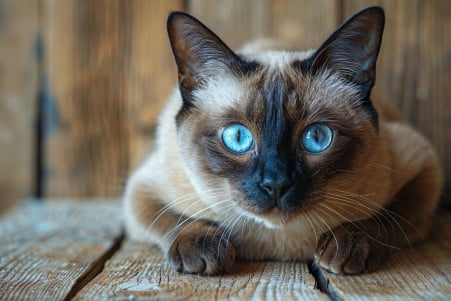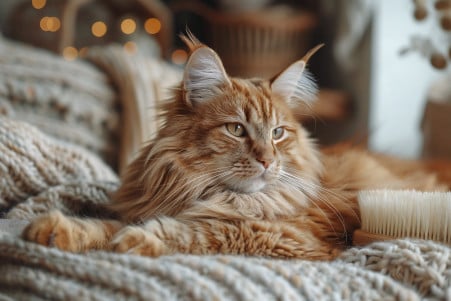Are Siberian Cats Low-Shedding? The Truth About Their Hypoallergenic Status
4 April 2024 • Updated 4 April 2024

Siberian cats are often marketed as a hypoallergenic breed, but are they really low-shedding? While no cat is truly hypoallergenic, Siberians are known to produce lower levels of the Fel d 1 protein that causes allergic reactions in many people. That said, they still shed and need to be groomed to keep their shedding and hairballs in check. With their semi-long double coat, Siberians have a moderate amount of shedding throughout the year, but they also have seasonal shedding periods.
To help answer the question of whether Siberian cats are low-shedding, this article will look at scientific studies that have investigated the genetics, grooming requirements, and potential allergen levels of Siberian cats in comparison to other breeds. This will help you better understand how to care for their beautiful fur, minimize dander, and determine whether or not they're a good option for people with allergies. By learning about these important biological factors, you can decide whether or not a Siberian cat is the right choice for you and your family.
Are Siberian Cats Low-Shedding?
The Siberian Cat's Unique Coat: Length and Structure
The Siberian cat's triple-layered coat is one of the reasons why they shed moderately. According to Siberian Reinhardt, the breed's coat is made up of a water-repellent guard layer, a thick insulating undercoat, and a soft downy layer close to the skin. This coat structure helps the breed regulate their body temperature and protects them from the elements in their native cold climate.
Siberians shed moderately throughout the year, but they do have heavier shedding periods in the spring and fall when they shed their winter and summer coats. According to Siberian Cat World, Siberians that have been spayed or neutered tend to shed more consistently throughout the year than those that haven't, and in general, Siberians' double coats make them heavier shedders than other long-haired breeds.
Regular grooming is important to prevent matting and control shedding, and the right tools are key. Emerald Kingdom Siberians suggests using slicker brushes, greyhound combs, and soft brushes to groom the breed's thick fur. Regular brushing, especially during peak shedding times, helps remove loose fur before it winds up all over your house. By keeping up with grooming, you can help keep their coats beautiful and their shedding under control.
Best Ways to Groom a Siberian Cat
As noted by Catster, Siberian cats need regular grooming to keep their long, thick fur in good condition. The site's experts recommend brushing your Siberian at least twice a week, and possibly even every day during the breed's semi-annual shedding seasons in the spring and fall. It's important to use the right grooming tools, including slicker brushes, steel combs, and de-shedding tools, to make sure you're getting rid of loose fur and preventing matting.
The Spruce Pets notes that it's important to make sure that the brush is easy for you to hold and that the bristles or teeth are designed for detangling or daily maintenance. As for the brushing process, Krypto Siberians says that you should work through the coat in layers, being careful not to pull too hard.
In addition to brushing, Krypto Siberians also recommends bathing your Siberian with a gentle, conditioning shampoo to help maintain the breed's natural oils, which are water-resistant. If you're having trouble with any part of the grooming process or if you find that you're not able to keep up with your cat's grooming needs, Catster says that you may want to take your cat to a professional groomer for help.
How to Deal With Seasonal Shedding
Because Siberians shed their winter and summer coats in the spring and fall, they will experience more shedding during these times. As explained by Siberian cat shedding patterns explained in detail, Siberian cats have a thick double coat that needs to be replaced regularly, so their shedding will be more noticeable during these two times of the year.
To deal with this, Cat & Dog Shedding: Why it Happens & How to Manage suggests daily brushing and frequent vacuuming. It can also be helpful to use lint rollers, furniture covers, and other practical solutions to help keep the hair under control.
As Untamed explains, it's important to make sure your cat is eating a high-protein diet and drinking enough water to help maintain a healthy coat and minimize excessive shedding. While there may be specific supplements or dietary changes that can help, it's important to talk to your vet before making any major changes.
By staying on top of seasonal shedding through regular grooming and a healthy diet, you can help keep the impact of Siberian cats' thick coats to a minimum in your home. This will help you get ready for the next important thing to think about - how much allergen a Siberian cat might produce.
The Hypoallergenic Debate: Are Siberian Cats Actually Low-Allergen?
The idea of hypoallergenic cats is based on breeds that produce less of the Fel d 1 protein, the main allergen that causes reactions in many people. Per Untamed, Siberian cats are often considered hypoallergenic because of genetic mutations that lead to almost no Fel d 1 production. However, studies have shown that the amount of allergens produced by Siberians can vary widely.
One study of 300 Siberian cats found that more than half had significantly lower allergen levels than feral cats, but a small percentage had high levels of allergens. CiderSpice Siberians of New England says that even cats with low allergen levels can have kittens with normal levels of allergens, and there's no guarantee that a cat will be completely allergen-free.
Other breeds that are often considered low-allergen are the Russian Blue, Sphynx, and Balinese. Per Litter-Robot, Siberians have a heavy shedding season in the summer that can temporarily increase their allergen levels. Pregnancy, kittenhood, and stress can also affect the amount of Fel d 1 that Siberians produce.
While Siberian cats are generally less allergenic than many other breeds, the wide range of allergen levels in individual cats means they can't be considered a guaranteed hypoallergenic choice. Prospective owners with allergies should assess their own reactions carefully and talk to a vet before bringing a Siberian cat into their home.
Dealing With Potential Health Problems in Siberian Cats
Siberian cats are known for their strong, athletic build and good overall health. However, according to Untamed, there are a few genetic and other health issues that they can be prone to.
Genetic health problems that are more common in Siberian cats include hypertrophic cardiomyopathy (HCM), a condition that causes the walls of the heart to thicken, and polycystic kidney disease (PKD), a genetic mutation that causes cysts to grow in the kidneys. Siberian Cat World also points out that pure white Siberians can be more susceptible to certain genetic cancers.
Other health issues that Siberian cats can be prone to include obesity, food allergies, and feline lower urinary tract disease (FLUTD), according to Catster. To help prevent and manage these issues, it's important to make sure your cat is eating a diet that's high in protein and low in carbs and that they're seeing the vet regularly.
Although Siberians' long, thick coats require a lot of grooming, Catster says that the structure of their fur doesn't present any special challenges when it comes to their potential health problems. By sticking to a regular grooming schedule, you can help keep shedding under control and prevent mats without making other health issues worse.
Conclusion: Understanding the Siberian Cat's Coat and Shedding
Siberian cats' luxurious, thick coats and moderate shedding are their most distinctive features. Although they're often said to be hypoallergenic, the truth is that the amount of the Fel d 1 allergen that Siberians produce can vary widely between individual cats. As a result, anyone considering getting a Siberian, especially if they have allergies, should be aware of the grooming commitment and the potential for allergens.
Regular brushing, especially during the spring and fall coat changes, is the best way to keep a Siberian's coat healthy and minimize the amount of hair that ends up on furniture and floors. In addition, owners should be prepared for the increased shedding that occurs during these seasonal coat changes.
By learning about the Siberian's coat and shedding patterns, you can make an educated decision and provide the best care for these beautiful, low-allergen cats.


